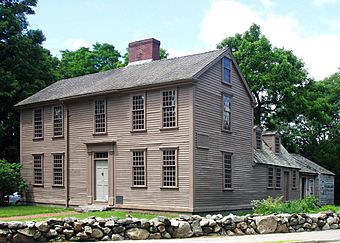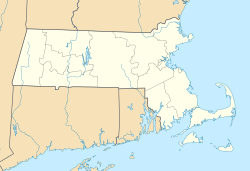Hancock–Clarke House facts for kids
|
Hancock–Clarke House
|
|

The Hancock–Clarke House, Lexington, Massachusetts
|
|
| Location | 36 Hancock Street, Lexington, Massachusetts |
|---|---|
| Built | 1738 |
| Architectural style | Early Georgian |
| NRHP reference No. | 71000895 |
Quick facts for kids Significant dates |
|
| Added to NRHP | July 17, 1971 |
| Designated NHL | July 17, 1971 |
The Hancock–Clarke House is a very old house in Lexington, Massachusetts. It is now a special place called a National Historic Landmark. This means it is important to the history of the United States.
The house was built in 1738. It is famous because John Hancock, a very important Founding Father of America, lived here as a child. He is known for signing the United States Declaration of Independence in a very big way! This house is the only one connected to him that you can visit.
The Hancock–Clarke House also played a big part in the start of the American Revolutionary War. On the night before the Battle of Lexington and Concord, John Hancock and Samuel Adams were staying here. They were leaders who wanted the American colonies to be free from British rule.
Today, the Lexington Historical Society runs the house as a museum. You can visit it on weekends starting in mid-April. It is open every day from May 30th to October 31st. There is a small fee to get in.
Contents
History of the Hancock and Clarke Families
Who Lived in the House?
The land where the house stands was bought in 1699 by Reverend John Hancock. He was the grandfather of the famous John Hancock. In 1738, Reverend Hancock built this two-story house. His son, Thomas, who was a rich merchant from Boston, may have helped pay for it.
The main part of the house has two floors and a central chimney. It has a small hallway and two rooms on each floor. There is also an attic upstairs. A smaller part of the house, called an ell, is at the back. It has a kitchen and a small study downstairs. Upstairs, it has two low-ceiling rooms.
Scientists used tree-ring dating to study the wood in the house. They found that both parts of the house were built at the same time. This means the smaller back part was not built earlier, as some people used to think.
John Hancock's Boyhood Home
In 1752, Reverend Jonas Clarke became the new minister and lived in the house. He raised 12 children there! Reverend Clarke strongly supported the American colonists' fight for freedom.
This house is one of only two homes still standing that are connected to John Hancock. He was a famous American patriot and the first Governor of Massachusetts. He became the President of the Continental Congress.
John Hancock came to live in this house in 1744 when he was seven years old. His father had passed away, so he moved in with his grandfather. In 1750, John went to live with his rich uncle, Thomas Hancock, in Boston. His uncle adopted him.
The Night Before the Battle
On the evening of April 18, 1775, John Hancock and Samuel Adams were guests at Reverend Clarke's house. They had been at a meeting in Concord and did not want to go back to Boston. They were worried the British might try to capture them.
Dr. Joseph Warren from Boston sent William Dawes and Paul Revere to Lexington. They rode to warn Hancock and Adams that British soldiers were coming. They arrived separately around midnight and told Hancock and Adams the news. After that, Dawes and Revere continued their ride to Concord.
To avoid being captured, Hancock and Adams quickly left the house. They went to Burlington to stay safe.
The House Today
Later Owners and Moving the House
The Hancock–Clarke House stayed in the Clarke family until 1844. Reverend Clarke's daughters took care of it. After that, the house was sold several times.
In 1896, the Lexington Historical Society bought the house. It was in danger of being torn down. The society saved it by moving it across the street. Later, in 1974, the society bought the original land where the house stood. They then moved the house back to its first location.
The house was named a National Historic Landmark in 1971. It was also added to the National Register of Historic Places.
What You Can See Inside
Today, the Hancock–Clarke House museum has furniture and pictures that belonged to the Hancock and Clarke families. There is also a special exhibit area. This area shows items from April 19, 1775, the day of the Battle of Lexington.
See also



